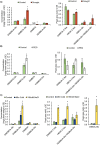The transcription factor TaMYB31 regulates the benzoxazinoid biosynthetic pathway in wheat
- PMID: 35554544
- PMCID: PMC9467655
- DOI: 10.1093/jxb/erac204
The transcription factor TaMYB31 regulates the benzoxazinoid biosynthetic pathway in wheat
Abstract
Benzoxazinoids are specialized metabolites that are highly abundant in staple crops, such as maize and wheat. Although their biosynthesis has been studied for several decades, the regulatory mechanisms of the benzoxazinoid pathway remain unknown. Here, we report that the wheat transcription factor MYB31 functions as a regulator of benzoxazinoid biosynthesis genes. A transcriptomic analysis of tetraploid wheat (Triticum turgidum) tissue revealed the up-regulation of two TtMYB31 homoeologous genes upon aphid and caterpillar feeding. TaMYB31 gene silencing in the hexaploid wheat Triticum aestivum significantly reduced benzoxazinoid metabolite levels and led to susceptibility to herbivores. Thus, aphid progeny production, caterpillar body weight gain, and spider mite oviposition significantly increased in TaMYB31-silenced plants. A comprehensive transcriptomic analysis of hexaploid wheat revealed that the TaMYB31 gene is co-expressed with the target benzoxazinoid-encoded Bx genes under several biotic and environmental conditions. Therefore, we analyzed the effect of abiotic stresses on benzoxazinoid levels and discovered a strong accumulation of these compounds in the leaves. The results of a dual fluorescence assay indicated that TaMYB31 binds to the Bx1 and Bx4 gene promoters, thereby activating the transcription of genes involved in the benzoxazinoid pathway. Our finding is the first report of the transcriptional regulation mechanism of the benzoxazinoid pathway in wheat.
Keywords: Rhopalosiphum padi aphid; Spodoptera littoralis caterpillar; Tetranychus urticae spider mite; Triticum aestivum; Abiotic stress; Triticum turgidum; biotic stress; herbivores; specialized metabolites.
© The Author(s) 2022. Published by Oxford University Press on behalf of the Society for Experimental Biology.
Figures




Comment in
-
New insights into the transcriptional regulation of benzoxazinoid biosynthesis in wheat.J Exp Bot. 2022 Sep 12;73(16):5358-5360. doi: 10.1093/jxb/erac244. J Exp Bot. 2022. PMID: 36095661 Free PMC article.
References
-
- Agarwal P, Kapoor S, Tyagi AK.. 2011. Transcription factors regulating the progression of monocot and dicot seed development. BioEssays 33, 189–202. - PubMed
-
- Altschul SF, Gish W, Miller W, Myers EW, Lipman DJ.. 1990. Basic local alignment search tool. Journal of Molecular Biology 215, 403–410. - PubMed
-
- Bailey TL, Noble WS.. 2003. Searching for statistically significant regulatory modules. Bioinformatics 19, ii16–ii25. - PubMed
Publication types
MeSH terms
Substances
Grants and funding
LinkOut - more resources
Full Text Sources

